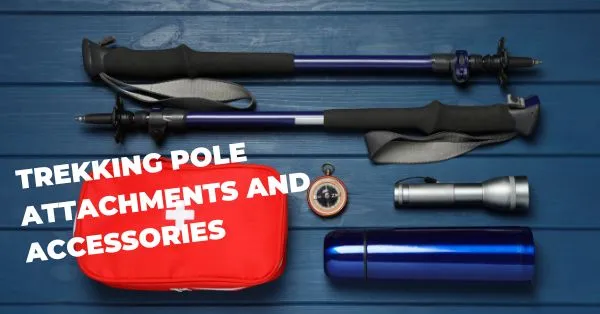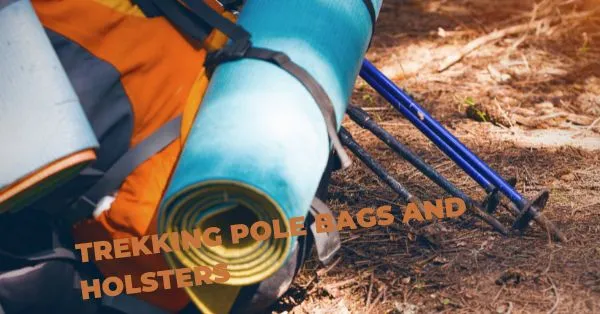Do you want to attach hiking poles to backpack and wanna know it how to do it properly? Then you’re at the right place. Hiking poles or trekking poles are essential accessories for outdoor enthusiasts and adventurers. They provide stability, balance, and support while trekking through various terrains. Attaching hiking poles to your backpack ensures convenience and easy access when not in use. This article will explore the proper methods and techniques for attaching hiking poles to a backpack. Ensuring they stay secure throughout your journey.
How to Attach Trekking Poles to a Backpack
Attaching hiking poles to a backpack requires a secure and stable method. Here’s a step-by-step guide to help you accomplish this:
Choose the Attachment Method: There are different attachment methods available, such as using external loops, bungee cords, or dedicated pole holders. Select the method that suits your backpack and personal preference.
Locate Attachment Points: Identify the attachment points on your backpack. These are typically located near the sides or bottom of the backpack. Use the side compression straps or gear loops if your backpack lacks dedicated attachment points.
Insert the Poles: Insert the tips of your hiking poles into the attachment points or loops on your backpack. Ensure the tips are securely inserted, and the poles are positioned vertically. This will prevent them from swinging or falling off during your hike.
Secure with Straps or Bungee Cords: If your backpack has straps or bungee cords specifically designed for securing hiking poles, utilize them to provide additional stability. Wrap the straps or cords around the poles, just above the handles or midsection, and fasten them tightly. This will keep the poles securely in place while you’re on the move.
Test for Stability: Once you’ve attached the hiking poles to your backpack. Gently shake them to ensure they’re securely fastened. They should feel stable and not wobble or move excessively. Readjust the attachment or straps for a snug fit if they’re not secure.
Trekking Pole Attachments and Accessories

Various attachments and accessories are available in the market to enhance the functionality of your hiking poles. These can further improve your hiking experience and make your poles more versatile. Here are some popular options:
Trekking Pole Attachments: These attachments include camera mounts, smartphone holders, and trail signs. They allow you to easily capture stunning photographs, navigate, and mark your trail during hikes.
Hiking Pole Accessories: Accessories like rubber tips, snow baskets, and mud baskets offer added adaptability for different terrains. Rubber tips provide traction on paved surfaces, while snow and mud baskets prevent your poles from sinking in softer ground.
Can I Bring Hiking Poles on a Plane?
Before delving into the attachment methods, addressing whether you can bring hiking poles on a plane is important. Transportation regulations can vary, so checking with the airline and relevant authorities beforehand is crucial. Generally, hiking poles are allowed as carry-on items. But it’s recommended to pack them in your checked baggage to avoid any complications during the security check.
Packing Hiking Poles for Flight
Proper packing is essential to ensure their safety if you aim to travel by air with your hiking poles. Here’s how you can pack your hiking poles for a flight:
- Disassemble the poles: Separate the sections of your hiking poles if they are adjustable. This will make them easier to pack and reduce the risk of damage.
- Protect the poles: Use padding materials such as bubble wrap or foam tubing to wrap around each section of the poles. This will provide cushioning and prevent them from scratching or bending during transportation.
- Place in a protective case: If you have a dedicated trekking pole bag or case, place the wrapped poles inside for additional protection. Alternatively, you can use a long, sturdy bag to accommodate the poles.
- Secure the case or bag: Close or tightly seal the bag to ensure the poles do not shift or move around. Use zip ties or thongs to secure the closure and keep everything in place.
- Check airline guidelines: Before your flight, double-check the airline’s guidelines regarding the dimensions and weight of carry-on or checked baggage. Ensure your packed hiking poles meet the requirements to avoid any issues at the airport.
Bonus:
Best Time to Go Hiking Premium Guide
Trekking Pole Holders and Straps
Some backpacks come equipped with dedicated trekking pole holders and straps. These features offer convenience and accessibility during your hikes. Here’s how to effectively use them:
- Locate the holders and straps: Identify the trekking pole holders on your backpack. These are usually elastic loops or pockets on the pack’s sides or front. Additionally, check for straps or bungee cords that can be used to secure the poles.
- Insert the poles: Slide the tips of your hiking poles into the holders or loops. Ensure they are snugly fit and positioned vertically.
- Secure with straps: If your backpack has straps, wrap them around the poles just above the handles or midsection. Fasten the straps tightly to hold the poles securely in place.
How to Tie Hiking Poles to a Backpack
When your backpack doesn’t have dedicated attachments or holders for hiking poles, you can use alternative methods to secure them. Here’s how to tie hiking poles to your backpack:
- Gather the necessary materials: You will need a length of cord or strap, approximately 3-4 feet long, depending on the size of your backpack.
- Position the poles: Place the hiking poles vertically against the back of your backpack, with the handles near the top and the tips at the bottom.
- Create loops: Take the cord or strap and loop it around the handle of one hiking pole, ensuring it is tight but not overly constricting. Repeat this step for the other hiking pole.
- Attach the loops to the backpack: Thread the loose ends of the cord or strap through the loops or straps on the sides or bottom of your backpack. Pull them tight to secure the poles.
- Adjust and secure: Make necessary adjustments to ensure the hiking poles are tightly secured to the backpack. Double-check that they are stable and won’t easily come loose during your hike. For more ideas, visit my Pinterest.
Trekking Pole Bags and Holsters

Trekking pole bags and holsters are designed to provide a convenient and protective storage solution for your hiking poles. Here’s what you need to know about them:
Trekking Pole Bags: These bags are usually durable and have compartments to hold your disassembled hiking poles. They offer protection from scratches, dings, and damage while keeping them organized.
Trekking Pole Holsters: Holsters are typically attached to the sides or front of your backpack and provide quick and easy access to your hiking poles. They securely hold the poles in place and allow you to grab them whenever needed without removing your backpack.
Conclusion
Attaching hiking poles to your backpack is a practical way to ensure they are readily accessible and securely fastened during outdoor adventures. Whether you choose dedicated attachments, straps, or alternative tying methods, the key is to prioritize stability and ease of use. Following this article’s guidelines and techniques, you can confidently attach hiking poles to backpack, enhancing your hiking experience and maintaining optimal functionality.
FAQs
Q.1 Can I bring hiking poles on a plane as a carry-on?
Ans: While policies may vary, it’s generally recommended to pack hiking poles in your checked baggage to avoid any issues during security checks. Check with your airline beforehand for specific guidelines.
Q.2 What attachments can I use with my hiking poles?
Ans: Various attachments are available, such as camera mounts, smartphone holders, and trail signs. These attachments can enhance the versatility of your hiking poles.
Q.3 How should I pack my hiking poles for a flight?
Ans: Disassemble the poles, wrap them with padding material, place them in a protective case or bag, and secure the closure. Ensure you comply with airline guidelines for carry-on or checked baggage.
Q.4 Are trekking pole holders and straps necessary?
Ans: While not essential, trekking pole holders and straps provide convenience and accessibility. They help keep your poles secure and easily accessible during your hikes.
Q.5 What if my backpack doesn’t have specific attachments for hiking poles?
Ans: In such cases, you can use alternative methods like tying the poles to your backpack using cords or straps. This allows you to secure the poles effectively, even without dedicated attachments.
Bonus:

